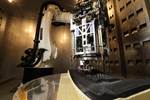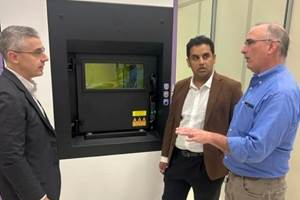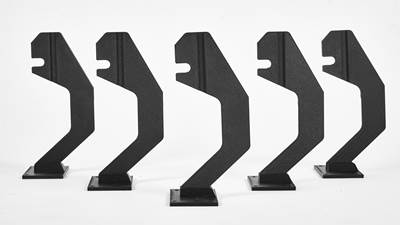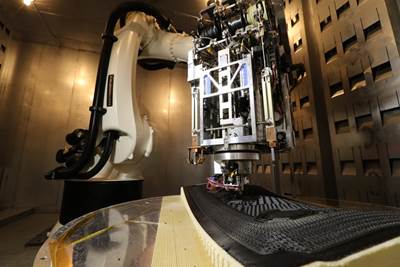Continuous fiber composites offer good mechanical properties, but can be difficult to apply in exactly the right configuration. Chopped fiber reinforced materials are easier to work with, but the shorter, randomly aligned fibers don’t provide equivalent strength. 9T Labs uses an unusual manufacturing strategy to achieve the best of both worlds: 3D printed continuous fiber preforms that reinforce a compression molded part otherwise formed from bulk molding compound including chopped fibers. In this bonus episode of The Cool Parts Show, we look at an airplane overhead bin pin bracket developed by 9T Labs and Purdue University. Two different versions — one with and one without the continuous fiber preforms — were created and tested, and we share the results. | This episode of The Cool Parts Show brought to you by Carpenter Additive
The Cool Parts Show is a video series from Additive Manufacturing Media that explores the what, how and why of unusual 3D printed parts. Watch more here.
Have a cool part to share? Email us.
Related Resources
- Previous episode comparing a composite bracket for a helicopter hinge to one machined from aluminum
- A deeper dive on this project from sister publication CompositesWorld
- Why “hybrid” composites like this may have an advantage over metals
- More on 9T Labs’ Additive Fusion Technology process
- SAMPE technical paper on this project (available for purchase)
Transcript
Peter Zelinski
00:00:08 - 00:00:09
I'm Pete.
Stephanie Hendrixson
00:00:10 - 00:00:13
I'm Stephanie. Welcome to the Cool Parts Show bonus episode.
Peter Zelinski
00:00:13 - 00:00:16
Stephanie, are you ready to revisit brackets?
Stephanie Hendrixson
00:00:16 - 00:00:19
I guess we could do one more episode on brackets.
Peter Zelinski
00:00:19 - 00:00:29
Here's some terrain we've covered before. 3D printed composite carbon fiber reinforced polymer as a means of producing a strong bracket structure.
Stephanie Hendrixson
00:00:29 - 00:01:03
So this is a pin bracket for the overhead bin of an airplane. It was made by 9T Labs. And this episode is a little bit of a follow up to our previous full length episode featuring a helicopter hinge bracket also produced by 9T Labs using their Additive Fusion Technology. So basically they are combining 3D printed continuous carbon fiber preforms with polymer or polymer composite, bringing everything together with a compression step. In that previous episode, we were comparing machined metal to the composite version of the bracket. In this case, it's a little bit different. We're going to be talking about composites versus composites.
Peter Zelinski
00:01:03 – 00:02:01
The 9T Labs process, it relies on 3D printing. It also includes a compression molding step. And you can see that in this form, there are some parting lines here from the molding. The primary role of 3D printing in this process is to get the carbon fiber reinforcement in the right place within the part, get the strength in the right place, in the right location and orientation, which is an important value of composites. In that previous bracket, 3D printing was used to create the carbon fiber reinforcement and also the planer plastic material that made up the form of the bracket. This bracket uses 3D printing only for that continuous fiber reinforcement. So in one sense it's using 3D printing more minimally, but in another sense it's concentrating 3D printing on just the most important part of the bracket form.
Stephanie Hendrixson
00:02:01 - 00:02:41
So this piece is the reinforcement for the base of the bracket. So you can see it
sort of loops around the holes there, providing some extra strength in the corners. And then this other piece is actually 3D printed as one, and then it gets cut in half each half then reinforces one of the ears for this bracket. So the process for manufacturing this part is these pieces get 3D printed on the 9T Labs, Build 3D printer, they get installed into the mold and then the rest of the mold is filled with a bulk molding compound. So in this case, it is a discontinuous fiber platelet material. You can sort of see what it looks like in the finished part here. Everything gets compression molded together.
Peter Zelinski
00:02:41 - 00:03:03
So this is a 3D printed bracket, even though 3D printing is just for this continuous carbon fiber PEKK material. The rest of the bracket form is filled with chopped fiber platelet and then during the compression molding step, this part in the base fuzes against this reinforcement to make the complete bracket.
Stephanie Hendrixson
00:03:03 - 00:03:14
So even though part of this bracket is 3D printed and part of it is molded, it's all composite. You've got both the continuous fiber composite and that chopped reinforcement as well. It's all composite.
Peter Zelinski
00:03:14 - 00:03:36
Continuous fiber is generally best in terms of reinforcement, but that's more complicated. And take some engineering to apply. Chopped fiber reinforcement is strong, but the directionality is random. The 9T Labs process is an attempt to find sort of a hybrid between those two best of both worlds.
Stephanie Hendrixson
00:03:37 - 00:03:49
And 9T Labs tested this. So they made two versions of this bracket, the one with the continuous fiber reinforcement that we have here, and one that is just the random chopped fiber version as well. We should talk about the results.
Peter Zelinski
00:03:49 - 00:04:35
The results according to 9T Labs and Purdue University, the version of this bracket with the continuous fiber reinforcement was twice as strong. Specifically, the load at which failure began was twice as large, with the reinforced version of the bracket, the continuous fiber reinforced version. In addition, the coefficient of variation was half as small, meaning the load at which that failure began varied within a tighter window test after test after test. So the reinforced bracket was not only stronger, but more consistently, more reliably stronger.
Stephanie Hendrixson
00:04:35 - 00:04:49
So this is a really cool illustration of how just a little bit of 3D printed, continuous fiber reinforcement can add a lot of strength, improve the performance of a bracket like this, and also give you more consistent strength. You will have more confidence about when it is going to fail.
Peter Zelinski
00:04:49,914 - 00:04:59
9T Labs, and the researchers at Purdue published a paper on their findings for the experiment with this bracket. We’ll include a link to that in the show description.
Stephanie Hendrixson
00:04:59 - 00:05:12
If you'd like to learn more about 3D printing of composites or see other cool brackets, you can find that original episode with 9T Labs linked in the show notes. There's also other great videos on our channel, and you can learn more at AdditiveManufacturing.media as well.
Peter Zelinski
Thanks for watching.
Related Content
Video: For 3D Printed Aircraft Structure, Machining Aids Fatigue Strength
Machining is a valuable complement to directed energy deposition, says Big Metal Additive. Topology-optimized aircraft parts illustrate the improvement in part performance from machining as the part is being built.
Read More8 Cool Parts From Formnext 2024: The Cool Parts Show #78
End-use parts found at Formnext this year address various aspects of additive's advance, notably AM winning on cost against established processes.
Read MoreNew Zeda Additive Manufacturing Factory in Ohio Will Serve Medical, Military and Aerospace Production
Site providing laser powder bed fusion as well as machining and other postprocessing will open in late 2023, and will employ over 100. Chief technology officer Greg Morris sees economic and personnel advantages of serving different markets from a single AM facility.
Read More3D Printed Titanium Replaces Aluminum for Unmanned Aircraft Wing Splice: The Cool Parts Show #72
Rapid Plasma Deposition produces the near-net-shape preform for a newly designed wing splice for remotely piloted aircraft from General Atomics. The Cool Parts Show visits Norsk Titanium, where this part is made.
Read MoreRead Next
Carbon-Filled Thermoplastic 3D Printing Material Replaces Handmade Metal Parts
The material enables 3D printing to produce a part that required replacement three times a month. Reduced labor and faster delivery times are the result.
Read MoreHow 3D Printing Will Change Composites Manufacturing
A Q&A with the editor-in-chief of CompositesWorld explores tooling, continuous fiber, hybrid processes, and the opportunities for smaller and more intricate composite parts.
Read MoreBike Manufacturer Uses Additive Manufacturing to Create Lighter, More Complex, Customized Parts
Titanium bike frame manufacturer Hanglun Technology mixes precision casting with 3D printing to create bikes that offer increased speed and reduced turbulence during long-distance rides, offering a smoother, faster and more efficient cycling experience.
Read More

.jpg;width=70;height=70;mode=crop)

















